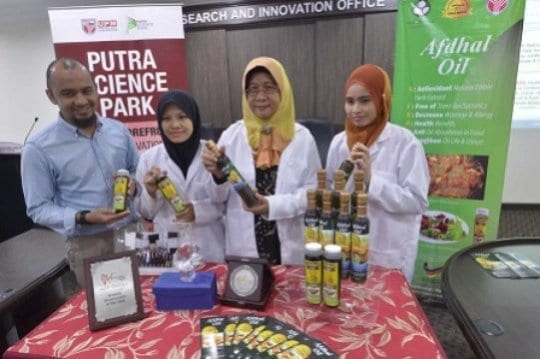
NEW GENOME: Our scientists beat the French to break the palm oil yield code
RECENTLY, scientists from the Malaysian Palm Oil Board (MPOB) made headlines. Their breakthrough in deciphering oil palm genome was well-received.
Dr Ravigadevi Sambanthamurthi, a fellow of the Academy of Sciences Malaysia who led the team, could not hide her excitement in a recent talk at the academy’s idea exchange event. The discovery promises to break the deadlock in palm oil yield, which has been stagnated for many years now. When that happens, palm oil production in Malaysia is set to expand again. This is also expected to bring comfort to the industry, which is under pressure from environmental groups calling for further restrain in opening new land for oil palm cultivation. With the expected 30 per cent improvement in yield, the oil palm will continue to widen its lead in productivity over other competing oils.
What exactly is the breakthrough? How significant is it? And, how would the findings be put to use? Though led by Malaysians, the team had collaboration from Orion Genomics, a United States biotech company. The discovery involves the identification of a single gene, called Shell, that is responsible for increasing the plant’s oil yield. It is significant in terms of scientific advancement, considering that two papers from the work were accepted for publication in the prestigious international journal, Nature. But more important is the potential the findings will have in bringing benefits to the palm oil industry. For decades now, palm oil is a source of nearly one-half of the supply of edible vegetable oil worldwide. This is now expected to be sustained for a longer term.
According to MPOB director-general Datuk Dr Choo Yuen May: “The discovery will have a significant impact on the Malaysian economy because for every one per cent increase in palm oil yields, Malaysia gains RM1 billion (US$330 million) in income.”
The oil palm that is widely grown in Malaysia is a hybrid of two varieties: dura, which has thick shells and therefore gives lower yield, and the shell-less pisifera, which makes processing difficult to separate the palm oil from the kernel oil. The hybrid of the two is the tenera, which is the common variety cultivated. It has a thinner shell than the dura and therefore has better yield.
Seed producers rely on selective breeding techniques to maximise plantings of tenera palms. The problem is that they often end up with up to 10 per cent of plantings may be the low-yielding dura. This arises because of the uncontrollable wind and insect pollination. Identifying whether an oil palm plantlet is the desired shell type can take six years. This can be costly because, by then, the trees cannot be uprooted. The identification of Shell has enabled the development of a simple molecular screen that can be used with seeds and plantlets to prevent the cultivation of undesired non-tenera plants, thereby, raising the efficiency of oil palm plantations.
The researchers also hope their public release of the genome will allow other scientists to pinpoint more genes that might be useful for improving oil palm trees, such as resisting drought and diseases.
“We’re not going to stop here,” said Ravigadevi.
The Latest Bing News on:
Oil palm research
- PetroChina's First-Quarter Net Profit Rose on Higher Sales -- Commodities Roundupon April 29, 2024 at 3:23 am
Brent crude oil is down 0.6% at $88.96 a barrel --European benchmark gas is down 2.7% to EUR28.14 a megawatt hour --Gold futures are ...
- Deforestation in Indonesia spiked last year, but resources analyst sees better overall trendon April 28, 2024 at 10:07 pm
During Indonesia's last El Nino in 2015-2016, fires intentionally started to clear land for agriculture rapidly spread, sending haze across Southeast Asia. Several Indonesian provinces declared states ...
- Palm oil production faces challengeson April 28, 2024 at 9:00 pm
The global palm oil market is expected to see steady growth in the coming year, but producers in the Asia-Pacific region are facing a mix of one-off factors that could impact supply.
- Revolutionizing Freshwater Production: Harnessing Solar Energy with Palm Oil Shellson April 28, 2024 at 7:34 am
PALMOILMAGAZINE, MEDAN – Water is an essential requirement for human survival, but with the growing population and industrialization, the availability of ...
- Election year a dampener on oil palm promotionon April 27, 2024 at 8:19 pm
Sri Lanka is unlikely to lift the ban on oil palm cultivation in an election year that has much at stake if this should go ahead. This industry has already lost approximately US$35 million in revenue ...
- New head of Oil Palm Research Institute assumes officeon April 24, 2024 at 9:08 pm
The new Director of the Oil Palm Research Institute (OPRI), a subsidiary of the Centre For Scientific and Industrial Research (CSIR), Dr Isaac Danso, has assured that he would work closely with all ...
- MPOB seeks to strengthen oil palm R&D strategieson April 24, 2024 at 4:32 pm
The Malaysian Palm Oil Board (MPOB) will analyse research projects and issues in the local oil palm industry to ensure that it will continue to drive growth and progress towards a lucrative and ...
- More sustainability in global agricultural tradeon April 22, 2024 at 9:31 am
The EU wants to ensure greater sustainability in agricultural trade with the Global South -- with the aim of minimizing the environmental and climate-damaging effects of importing crops such as soya, ...
- Research suggests ways to ensure more sustainability in global agricultural tradeon April 18, 2024 at 1:44 pm
The EU wants to ensure greater sustainability in agricultural trade with the Global South—with the aim of minimizing the environmental and climate-damaging effects of importing crops such as soya, ...
- Busoga farmers abandon sugarcane, opt for oil palmon April 17, 2024 at 1:31 am
“ We have identified oil palm as a crop that can alleviate people out of poverty in Busoga. A farmer can collect Shs500,000 in an acre every month, that is Shs2.5m in five acres every month. The ...
The Latest Google Headlines on:
Oil palm research
[google_news title=”” keyword=”Oil palm research” num_posts=”10″ blurb_length=”0″ show_thumb=”left”]
The Latest Bing News on:
Palm oil production
- Hope for the Welfare of Planters from Rejuvenation of People's Palm Oilon April 30, 2024 at 12:07 am
The smallholder oil palm rejuvenation program has the potential to have a positive impact on farmers' welfare.
- Main Market debutante MKH Oil Palm says no replanting activities in coming yearson April 29, 2024 at 11:44 pm
Bhd (MKHOP), fresh off its Main Market debut on Tuesday, said it has no replanting plans as almost all of its prime mature oil palm trees are over a decade-old. With approximately 94.9% of its total ...
- Palm oil extends gainson April 29, 2024 at 3:43 pm
Dalian’s most-active soyoil contract gained 0.95%, while its palm oil contract added 1.39%. Soyoil prices on the Chicago Board of Trade were up 0.44%. Palm oil is affected by price movements in ...
- Palm oil production faces challengeson April 28, 2024 at 9:00 pm
The global palm oil market is expected to see steady growth in the coming year, but producers in the Asia-Pacific region are facing a mix of one-off factors that could impact supply.
- Revolutionizing Freshwater Production: Harnessing Solar Energy with Palm Oil Shellson April 28, 2024 at 7:34 am
PALMOILMAGAZINE, MEDAN – Water is an essential requirement for human survival, but with the growing population and industrialization, the availability of ...
- Plantation minister: Govt is serious in resolving palm oil industry issueson April 27, 2024 at 1:40 am
The Malaysian government is serious in resolving the issues surrounding the palm oil industry in the country, said Plantation and Commodities ...
- South Kalimantan Integrates Palm Oil Rejuvenation with Upland Rice Plantingon April 24, 2024 at 2:42 am
Oil palm plants are starting to be integrated with upland rice in the people's oil palm rejuvenation program in South Kalimantan.
- Palm oil surrenders gains amid higher expected production, weaker oilon April 21, 2024 at 11:22 pm
SINGAPORE: Malaysian palm oil futures erased early gains on Monday and were set for a seven-session decline as expectations of higher palm production narrowed differentials among rival edible oils, ...
- Snack Giant PepsiCo Sourced Palm Oil From Razed Indigenous Landon April 18, 2024 at 8:30 am
Palm oil production in Peru has more than doubled in the past decade and Ucayali, a hotspot for cultivation on the border with Brazil, now has the country’s second-highest rate of forest loss. It’s ...
- More sustainability in global agricultural tradeon April 17, 2024 at 5:00 pm
The researchers found that over 80% of the land deforested for EU production is used to grow soya, palm oil, cocoa, and coffee. The EU wants to ensure greater sustainability in agricultural trade ...
The Latest Google Headlines on:
Palm oil production
[google_news title=”” keyword=”palm oil production” num_posts=”10″ blurb_length=”0″ show_thumb=”left”]










